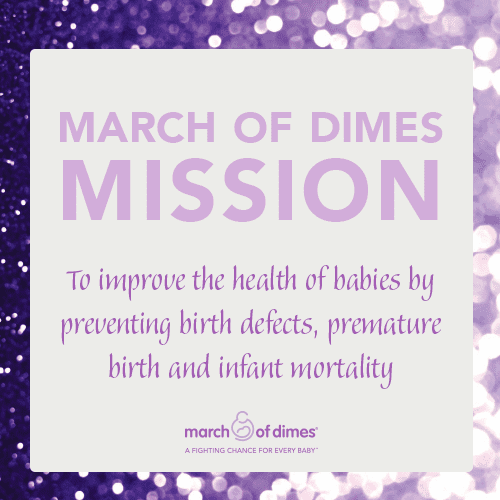March of Dimes helps moms have full-term pregnancies and healthy babies. And, if something goes wrong, we offer information and comfort to families while researching the problems that threaten our babies and work on preventing them. We work to give every baby a fighting chance.
FROM POLIO TO PREMATURITY
It was his personal experience with polio that inspired President Franklin Roosevelt to found the March of Dimes in 1938 to defeat the crippling disease. Success came in the form of a vaccine, and there has not been a single outbreak of polio in our country in more than 30 years.
For the March of Dimes, the polio vaccine was only the beginning. In the decades to follow, March of Dimes helped to stamp out rubella, pushed for regionalized newborn intensive care, funded and the development of surfactant therapy and other lifesaving treatments, promoted folic acid to prevent neural tube defects and brought newborn screening to every baby.
Researchers are working hard to find causes, treatments and preventions for the serious problems that threaten babies’ health. Just as March of Dimes funded Dr. Jonas Salk’s effort decades ago to develop an effective polio vaccine, today they support grantees working in the areas of developmental biology, birth defects and premature birth.
The March of Dimes continues to work to prevent stories like that of the Gale family. Here is their story as told by Angela Gale:
It has been almost five years since we had to say goodbye to Samantha.
Our pregnancy with Samantha had been full of tests because I was already over 35. Early in the pregnancy with her I had a blood clot and had been told I might go into premature labor. I felt great throughout my pregnancy and continued to follow my normal routine and did not think twice about it. I never would have guessed that I would have had her at 24 weeks; weighing just 13 oz. I know this heartbreak and joy is part of our story to share.
We spent months at the hospital everyday anxiously waiting for the day we could take her home. There were some very scary moments throughout our stay. Samantha’s biggest obstacle was her lungs. The doctors, nurses, and respiratory therapists worked around the clock to care for her. We formed life-long bonds with them and carry so many memories. More times than I can count we would have questions or concerns and the nurses would sit there with tears in their eyes because they could not give us the answer that we most wanted-a definite answer that our baby would live a long life. I know that she would not have made it past a few weeks had not so many discoveries been made in the medical field with premature babies.
After 220 days in the hospital, we went home with a feeding tube and oxygen. We had prayed and dreamed of the moment when we could finally take her home; but it proved to be a huge challenge. As it happens with newborns, we rarely slept. Only she wasn’t a newborn. She was almost 10 months old. That time at home showed us just how difficult it is both as a new parent and taking care of someone with health issues. Vic and I were stretched in ways we did not even know was possible yet we were so blessed. Parents often say they cannot imagine losing a child and neither could we until it actually happened. We had to say goodbye to Samantha.
When we lost her, neither Vic nor I knew how we would ever move on. We were struggling to adjust to all of the changes and force ourselves to move on when we found out we were pregnant again. We actually had just had blood tests done to make sure we could carry another baby when we found out we were pregnant. It was such a wonderful surprise. I sat on the floor and cried for hours both from grief and the relief that we could get pregnant again. We were nervous but overjoyed that we had another baby on the way.
I went back and forth between worrying constantly and being at peace with the pregnancy. I had been pretty careful in my pregnancy with Samantha and with Sara’s pregnancy, I knew things would progress as they were supposed to. The perinatal doctors and my OB-GYN were wonderful. They answered all of our endless questions. They had several suggestions that we followed to ensure as much as humanly possible that Sara was a full-term baby. I remember hitting that 24 week mark and being overjoyed that Sara was healthy. We were still grieving Samantha but tried to stay focused on this beautiful gift that we had been given.
Sara is now an amazing four year-old. She is strong-willed, funny, and keeps us on our toes. We talk about Samantha quite often and although Sara does not understand a lot of it, we continue to celebrate her life as well as the amazing gift we have been given through Samantha. While trying to find pictures for this article, Sara came and sat beside me and we watched videos and looked at pictures of Samantha. Sara wanted to watch the video over and over again. She thought Samantha was so funny and loved that they both shared a love for pacifiers. She even asked to sleep with hers that night. I will always wonder about the relationship they would have shared as sisters and the journey their life would have taken together. Life does not always turn out the way you plan it, but I am grateful for two amazing daughters who have forever changed us with their stories. Not only are we blessed by their lives but we are blessed by the numerous people who took care of us, loved us, and prayed with us along the way.
In 2017, the March of Dimes will launch its Healthy Babies are Worth the Wait (HBWW) program in Louisiana, which will include in Shreveport, the city with the highest preterm birth rate in the country. Overall, the state has six confirmed sites within a nine-parish region.
HBWW is an initiative to encourage healthy, full-term births. Through education of women and health care providers, quality improvement activities with hospitals, and awareness activities, Healthy Babies are Worth the Wait helps reduce the number of non-medically necessary labor inductions and elective cesarean sections before 39 weeks gestation, and emphasizes that the last few weeks of pregnancy are key for an infant’s development.
The hospitals, along with their clinics and other community partners, also will focus on other known interventions such as the use of progesterone injections for women with a history of prior preterm birth and education around birth spacing. The collaborative has support from the state Maternal Child Health Department and health units as well.
In addition, March of Dimes is partnering with the State of Louisiana’s Bureau of Family Health’s Maternal and Child Health Department on CityMatch, a cohort specifically looking at health equity as it relates to prematurity and infant mortality. With the help of state data and investigative evaluation reports, best practices will be selected and implemented within these high-risk parishes. Community leaders, patients and national attention from both CityMatch and March of Dimes, we are working to give every baby a fighting chance within Louisiana, specifically in the Shreveport/Bossier City area.














